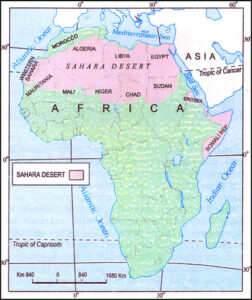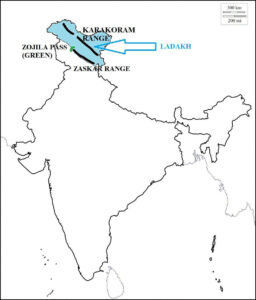NCERT Solutions for 7th Class Geography 9th Chapter
Desert regions are portrayed by low precipitation, inadequate vegetation, and outrageous temperatures. Contingent upon the temperatures, there can be hot deserts or cold deserts. The Sahara desert is the most smoking and the world’s biggest desert. Ladakh is a virus desert that lies in the Great Himalayas, on the eastern side of Jammu and Kashmir. The NCERT Solutions for 7th Class Geography 9th Chapter is exact and exact, assisting you to contrast your responses rapidly. It covers every one of the subjects as referenced in the sections.
Chapter 9: Life in the Deserts
You can also get the NCERT Solutions for 7th Class for different subjects at the connected article.
NCERT Solutions for 7th Class Social Science 9th Chapter – Life in the Deserts – Download PDF
TEXTUAL QUESTIONS
Ques 1. What are the two types of deserts found in the world?
Ans. Two types of deserts found in the world:
i) Hot deserts.
ii) Cold Deserts.

Ques 2. In which continent is the Sahara desert located?
Ans. The Sahara Desert is located in the continent of Africa.
Ques 3. What are the climatic conditions of the Ladakh desert?
Ans. Climatic conditions of the Ladakh Desert:
i) Climate is extremely cold and dry.
ii) Due to high temperature, the air is thin and the heat of the sun is felt intensely.
iii) Day temperatures are just above 0O C. and night temperatures go up to – 30O C in the winter season.
iv) It is freezing cold in winter, temperatures may remain below – 40O
v) Rainfall is only 10 cm annually because of the area lying in the rain shadow region of the Himalayas.
vi) Ladakh desert experiences freezing winds and burning hot sunlight during the day.
vii) If one sits in the sun, and his feet in the shade he may suffer from sunstroke and frostbite at the same time.
Ques 4. What mainly attracts tourists to Ladakh?
Ans. i) Gompas
ii) Treks to see meadows
iii) Ceremonies and festivities
Ques 5. What type of clothes do the people of the Sahara desert wear?
Ans. i) Clothes made of the hair of the animals.
ii) Heavy clothes as protection against dust storms and hot winds.
Ques 6. Name the trees that grow in Ladakh.
Ans. i) Willows and Poplars.
ii) Fruit trees which bloom during summers. Ex:- Apples, Apricots, Walnuts.
Tick the correct answer.
(i) Sahara is located in which part of Africa
(a) eastern
(b) northern
(c) western
Answer: b
(ii) Sahara is what type of desert
(a) cold
(b) hot
(c) mild
Answer: b
(iii) The Ladakh desert is mainly inhabited by
(a) Christians and Muslims
(b) Buddhists and Muslims
(c) Christians and Buddhists
Answer: b
(iv) Deserts are characterized by
(a) scanty vegetation
(b) heavy precipitation
(c) low evaporation
Answer: a
(v) Hemis in the Ladakh is a famous
(a) temple
(b) church
(c) monastery
Answer: c
(vi) Egypt is famous for growing
(a) wheat
(b) maize
(c) cotton
Answer: c
Match the following.
| (i) Oasis | (a) Libya |
| (ii) Bedouins | (b) monastery |
| (iii) Oil | (c) glacier |
| (iv) Gangri | (d) depressions with water |
| (v) Lamayuru | (e) cold desert |
| (f) Sahara |
Answer:
| (i) Oasis | (d) depressions with water |
| (ii) Bedouins | (f) Sahara |
| (iii) Oil | (a) Libya |
| (iv) Gangri | (c) glacier |
| (v) Lamayuru | (b) monastery |
Give reasons.
1. There is scanty vegetation in the deserts.
There is scanty vegetation in the deserts because of the following reasons :
i) Vegetation depends on two factors climate and soil.
ii) Climate in the deserts is either very hot and dry or very cold and dry.
iii) Such climate does not allow the growth of vegetation.
iv) Rainfall is scanty. Hence vegetation does not grow in dry conditions.
v) Soil is either sandy (in hot deserts) or covered with snow (cold deserts) for most of the
vi) Both types of soil do not encourage vegetation to grow.
2. People of the Sahara desert wear heavy robes.
i) Robes of the people of the Sahara Desert are made of hides of animals or hair of animals.
ii) These robes are heavy:
a) They protect the people from the scorching sun and extreme heat.
b) They protect the people from dust storms and hot winds.
Map skills.
(i) On the outline map of Africa, marks the Sahara desert and any four countries around it.

(ii) On the outline map of India, mark the Karakoram Range, Zanskar Range, Ladakh and Zoji La pass.

Life in the Deserts Summary
Chapter 9 – Life in the Deserts from the NCERT geography book discusses:
- The Hot Sahara Desert
- Environment
- Greenery
- Individuals
- The Cold Desert – Ladakh
- Greenery
- Environment
- Individuals
The NCERT Geography book for 7th Classis ‘Our Environment’ and students can get answers for every one of the sections at INFINITY LEARN. For NCERT Solutions for 7th Class Social Science, visit the connected article.
Frequently Asked Questions on NCERT Solutions for 7th Class Geography 9th Chapter
- What number of questions is available in NCERT Solutions for 7th Class Geography 9th Chapter?
- What are the climatic conditions of the Ladakh desert according to NCERT Solutions for Class 7 Geography Chapter 9?
- What are the key topics covered in NCERT Solutions for Class 7 Geography Chapter 9?
1. What number of questions is available in NCERT Solutions for 7th Class Geography 9th Chapter?
NCERT Solutions for 7th Class Geography 9th Chapter contains 4 primary questions altogether. They are short responses; the last 3 questions are of the sort giving reasons, match the accompanying and MCQs covering every one of the vital subjects of the part. The responses to these questions are planned by a bunch of subject specialists at INFINITY LEARN having immense involvement with the instruction field.
2. What are the climatic conditions of the Ladakh desert according to NCERT Solutions for Class 7 Geography Chapter 9?
Ladakh is a virus desert that lies in the Great Himalayas. The elevation of Ladakh fluctuates from 3000m to 8000m, in light of which the environment is freezing and dry. The air at this height is exceptionally slender and it increases the hotness from the sun. The temperature in winters is not exactly – 40°C and the day temperature in summers is simply over zero degrees.
3. What are the key topics covered in NCERT Solutions for Class 7 Geography Chapter 9?
The key subjects canvassed in NCERT Solutions for 7th Class Geography 9th Chapter are
The Hot Sahara Desert
- Environment
- Verdure
- Individuals
The Cold Desert – Ladakh
- Verdure
- Environment
- Individuals



